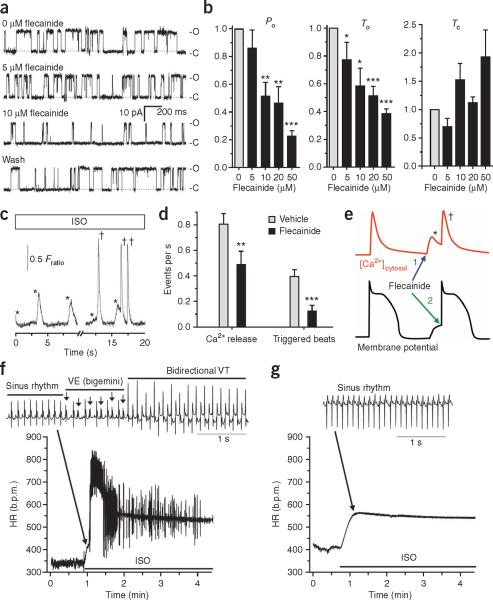Figure 1.
Flecainide inhibits RyR2 Ca2+ release channels, reduces spontaneous Ca2+ release events and triggered beats and prevents ventricular tachycardia in a CPVT mouse model. (a) Representative examples of the activity of single sheep RyR2 channels incorporated in lipid bilayers in response to 0, 5 and 10 μM flecainide followed by washout. C, closed; O, open. (b) Average concentration dependence of flecainide's effect on RyR2 open probability (Po), mean open time (To) and mean closed time (Tc). Data are expressed relative to values at 0 μM flecainide, with absolute Po = 0.12 ± 0.07, To = 13.5 ± 4.4 ms and Tc = 146 ± 56 ms. RyR2 channels were activated by 1 mM Ca2+ on the trans (luminal) side with cis (cytosolic) at 0.0001 Ca2+ mM (to model resting Ca2+ concentration). n = 3–8 experiments per concentration; *P < 0.02, **P < 0.01 and ***P < 0.001. (c,d) Effects of flecainide on isoproterenol (ISO)-stimulated Casq2−/− myocytes. (c) Representative examples of spontaneous sarcoplasmic reticulum Ca2+ release events (*) and triggered beats (†). Fratio, Fura-2 fluorescence ratio, which is proportional to free intracellular Ca2+ concentration (see Supplementary Methods online). (d) Flecainide (6 μM, >10 min incubation) significantly decreased spontaneous sarcoplasmic reticulum Ca2+ release events and triggered beats (n = 44 cells) compared to vehicle (n = 45 cells). **P = 0.0078 and ***P < 0.001. (e) Cartoon illustrating the dual mechanism of flecainide action: (1) inhibition of the sarcoplasmic reticulum Ca2+ release (*) that causes delayed after depolarizations and (2) inhibition of the premature beats (†) that are triggered by delayed after depolarizations. (f) Heart rate response to ISO (1.5 mg kg−1) challenge in a Casq2−/− mouse. As illustrated in the ECG trace, the rapid and irregular heart rate (HR) was the result of numerous repetitive ventricular extrasystoles (VE, arrows) and the induction of ventricular tachycardia (VT). b.p.m., beats per minute. (g) Heart rate of the same mouse after it received flecainide (20 mg kg−1) 15 min before ISO challenge. All data are means ± s.e.m.; for experimental protocols and statistical analysis see Supplementary Methods. Animal experiments were approved by the Vanderbilt University Medical Center Institutional Animal Care and Use Committee.

